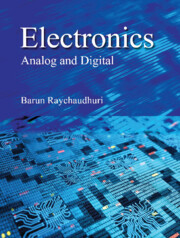Book contents
Chapter 8 - Transistor Power and Multistage Amplifiers
Summary
The essential conditions for a bipolar junction transistor to work as power amplifier are illustrated in this chapter. Sometimes the output of an amplifier is used as the input of another amplifier in order to produce larger amplification. Such cascading of two or more amplifier stages is called coupling, which may be done with resistor, capacitor transformer, or with direct connection. Different types of coupling and the resultant multistage amplifiers are discussed. Several classes of amplifier operation, such as A, B, AB and C are introduced. Some specific types of biasing techniques suitable for transistor power amplification, such as push–pull and tuned amplifier are explained.
Need for Power Amplification
In Chapters 5 through 7, we have come across different types of transistor configurations and biasing circuits acting as voltage or current amplifiers. The amplifier converts a portion of the electrical energy obtained from the dc power supply into the energy obtained at the output in proportion to the input. The input signal just controls the mode of conversion. There are wide varieties of amplifier depending on the requirement of
• ac or dc amplification,
• voltage, current, or power amplification,
• amplification over a wide range of frequency of the input signal (wideband amplifier), and
• amplification around only a fixed frequency of the input signal (narrowband or tuned amplifier) and many others.
The loudspeaker in a public address system is a very common example where high level amplification is required for a weak electrical signal. Servomechanisms, such as the movement of the motor in a printer connected to a computer and signal transmissions in radio/television broadcasting are other popular examples where high level amplifications are compulsory. Such large extent of amplification cannot be achieved with the BJT amplifiers discussed in Chapters 6 and 7 because of the following constraints.
(i) Achieving voltage gain is not possible for large signals because the ositive and negative swings of a large (≥ 0.7 V) ac input would drive the Q-point to saturation and cutoff, respectively.
(ii) The current gain can still be achieved because it is the fundamental property of the transistor.
(iii) The nonlinearity in the transistor transfer characteristic becomes predominant for large input signals.
- Type
- Chapter
- Information
- Electronics , pp. 239 - 275Publisher: Cambridge University PressPrint publication year: 2023



